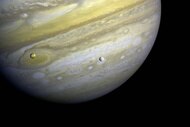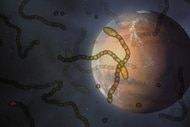Create a free profile to get unlimited access to exclusive videos, sweepstakes, and more!
Why Jupiter could be the final girl of the solar system - until a star kicks it out

Around 5.4 billion years from now, a space horror will happen. The Sun will fall into the throes of a fiery death, blowing up into a red giant that will easily devour Mercury, Venus, Earth and possibly Mars, and then lose half its mass. Without the Sun’s gravity to keep them in their orbits, the outer planets will end up going rogue. Neptune? Don’t know her.
Jupiter will probably be the final girl in all this. Because the gas giant is so massive, it has the greatest gravitational bond with our star, and it will for a while even as that star is dying. The problem is that the Sun’s mass will keep decreasing as it transitions from the red giant stage to the white dwarf stage during the next 7 billion years. As the Sun shrinks, Jupiter will not be so gravitationally bound to it anymore, which will make it susceptible to encounters with passing stars every 20 million years or so. Either these bypassers will shove the unstable Jupiter from its orbit until it gets the hint — or one ginormous one kicks it out.
“It does not require a very massive star to remove Jupiter from the grips of the Sun,” Jon Zink, a UCLA astronomy grad student who led a study recently published in The Astronomical Journal, told SYFY WIRE. “Through a simulation, we found that it takes roughly 4,000 stellar flybys to dissociate Jupiter, but most of these are very distant and have little impact on the system. We just need to wait a long time for one of them to approach close enough to eject the planet.”
When the Sun goes down for good, Zink believes that the most likely fate for those planets which aren’t engulfed by a great ball of red giant fire will orbit the center of the galaxy on their own, at a radius of about 53,000 light years, similar to that of their solar orbits. These independently orbiting planets will develop larger and larger orbits as the sun loses its gravitational hold on them, and eventually make for the other side of the galaxy. However, there are some weirder and less likely scenarios. There could be a star with enough gravity to snatch up one of the outer planets on a flyby if it sneaks up on that planet at just the right distance and speed.
Another alternative scenario imagines a trespassing star that could use a gargantuan amount of energy to boot one of those planets out of the Milky Way to who knows where.
Seeing into the far future required N-body simulations, which simulate interactions in constantly changing systems. These types of simulations can be used to predict what will happen to everything from the tiniest particles to the largest planets, such as Jupiter, which was shown to lose gravitational force between it and the sun by a factor of 6. Jupiter and Saturn will lose their orbital resonance, meaning their orbits will become unstable since they will no longer exert stable gravitational forces on each other. This will happen because of the Sun’s inability to hold onto them. As the Sun continues to lose its grip on Jupiter, the planet will become vulnerable to outside forces.
If Jupiter or another planet were to be violently thrown out of the galaxy like that, its velocity would have to power up to 50 times more than what Zink’s simulations showed, but something like this happening isn’t impossible. N-body simulations still may not be telling us everything. The universe is dynamic, always changing and revealing unexpected things which nobody might be predicting right now.
“There remain several unknowns that could affect our results,” Zink said “The mass loss model used here assumes perfect understanding of the underlying physical processes the Sun will undergo over it’s lifetime. Should new mechanisms be discovered, this model will change, along with expected future evolution.”
Binary stars were not included because they would complicate the work, but Jupiter could possibly end up being the victim of a binary star system. Nevertheless, the star (or stars) most likely to fling Jupiter into interstellar space will have to be both big enough to content with such a behemoth, but also in the right place at the right time, and at the right speed. Stars of solar mass or less to will have an effect on the imposing planet, because there are so many of these smaller stars scattered around the galaxy. Zink believes it is most likely that one fiery orb that meets all the right conditions will exile Jupiter from the Milky Way.
“While stellar mass does affect the magnitude of the interaction, the more important parameter is the distance of closest approach,” he said. “While both quantity and interaction strength play a role here, we found that a single close encounter will be the major cause of Jupiter’s liberation, meaning that a close encounter is likely to come along and eject the planet before the small distant interactions are able to fully accumulate.”
This year might have been a dumpster fire on Earth, but other planets will someday have their own dystopian eras. Jupiter, brace yourself.


























